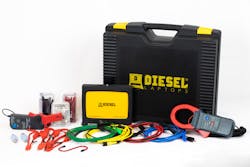Scope diagnostics brings heavy-duty electrical issues into focus
Scope diagnostics was not something a heavy-duty technician ever really needed when trucks were mostly mechanical. A basic tool such as a multimeter was typically more than enough technology to help diagnose electrical issues. However, electrical systems are becoming more prominent and complex on today's commercial vehicles.
"Gone are the days when heavy duty vehicles had three ECMs (engine control modules): engine, transmission, and ABS," says Chris Freeman, director of sales/training HD at Autel, a developer of diagnostics, detection, and analysis systems. "I've seen trucks with as many as 20 ECMs."
With that increased electrical complexity comes an increased need for better problem-solving tools.
"Today's fleet technicians need more engineering-type tools to help diagnose electrical issues," says Dustin Carnes, training manager for Diesel Laptops, a provider of both OE and aftermarket diagnostic hardware, software, training, and support.
Carnes is referencing a tool engineers have used for years: an oscilloscope. An oscilloscope is essentially an extension of a multimeter.
"If you think of a multimeter in terms of an old film camera, an oscilloscope is more like a high-definition video camera," Carnes relates. "A scope allows you to really zoom in and get very granular in terms of what you can see in the electronics."
Carnes points to a couple specific areas where electrical systems are becoming more prominent in heavy duty vehicles.
"Emissions standards continue to be added," Carnes says. "Manufacturers also continue to add creature comfort features such as HVAC systems in the back of trucks. Then there are new safety features like ADAS (advanced driver assistance systems) with complex sensors and radar that are all multiplexed together into one system controlled by one body controller. Even things that used to be pretty simple, like sensors in an exhaust system, are now multiplexed and running over the CAN bus instead of just being wired to the ECM. The more complex things get, the more sophisticated the diagnostics become."
How a technician can benefit from a scope
An example of where an oscilloscope can be of benefit is when diagnosing EGR (exhaust gas recirculation) issues. Freeman says a trouble code for EGR position failure is typically related to one of two things: a bad sensor or a bad EGR itself.
"When you measure EGR position with a standard diagnostic tool, it will basically tell you if the EGR is on or off, or that there needs to be an automated test for it," Freeman points out. "But many OEs do not do these automated tests."
With an oscilloscope, a technician can get to the root of the problem.
"The test is fairly easy for most technicians to do with a four-channel scope," Freeman says. "One probe goes to a 5-volt reference on the EGR sensor, one goes to the ground, one goes to the ground on the EGR position itself, and the fourth probe goes to the 5-volt reference on the EGR position. Then, you run voltage through the system so you can check both things at the same time. You're checking the position sensor to make sure it is functioning properly, but you're also checking the motor to make sure it isn't requiring more voltage to operate, which would indicate that there's resistance. Quite simply, a scope can allow a technician to see things a scan tool can't see."
In other instances, an oscilloscope can make existing processes a lot more efficient.
"Take a relative compression test where a technician checks the balance between each cylinder on an engine," Carnes says. "Some manufacturers have this built into their software, but some do not. When they don't, a technician has to start pulling an engine apart to visually inspect for mechanical issues. When using an oscilloscope, a technician can get the information he or she needs in a lot less time, probably three or four hours less."
There are also instances where a scope is simply a better tool than what is normally being used.
"If you think about the CAN bus J1939 where data is moving at 250 to 500 kilobytes per second, a multimeter cannot keep up and provide the information the technician needs," Carnes explains.
When that happens, the multimeter might diagnose some intermittent issues. Sometimes a truck comes in with inactive fault codes. The multimeter can't see anything that's wrong.
"That's where you could hook up an oscilloscope to analyze the sine waves coming from those modules, which can help pinpoint things that don't look right," Carnes adds.
Getting started with scope diagnostics
To begin taking advantage of scope diagnostics, Carnes says most fleets are looking to modern digital storage oscilloscopes. The scope itself has leads on it similar to a multimeter. The scope also has a USB cable that connects to a laptop or tablet. Software collects all of the data so the technician can view and analyze it.
"The hardware [scope] goes directly to a sensor or module on a truck," Carnes explains. "The technician hooks it up directly by either back probing the sensors or using breakout harnesses or amperage clamps, depending on what the tech is doing. The most difficult part of getting into scope diagnostics is knowing where to hook up the tool to get the right readings."
That is why supplier support is so critical. A good supplier will not only provide a good tool, but also training and support so the technician can make the most of their new scope.
Freeman says there are a handful of oscilloscopes geared toward the heavy duty market. Some are rather high-end with a price tag as high as $10,000. Autel's scope, the MaxiScope MP408, is designed for a technician who is just getting started with scope diagnostics.
An example of useful, high-end functionality is the ability to stack sine waves. Think back to the earlier example of trying to diagnose whether an EGR issue was sensor-related or the EGR itself.
"With a high-end oscilloscope, you can monitor movement of the EGR position sensor and the actuator itself," Freeman says. "You can record both, and then overlay the sine waves to see if the sensor matches up with the actuator. If they don't match up, you know the sensor is bad."
Another example of high-end scope functionality has to do with something called packet descriptions. Freeman likens that to name tags for ECMs.
"When you connect an oscilloscope to a vehicle with multiple ECMs, there are a lot of sine waves coming back to you," Freeman explains. "With a scan tool, you also get a lot of different information on a lot of different systems. But with a scan tool, the information is populated and labeled. Not all oscilloscopes do that. A high-end scope will, which helps the technician know what he or she is looking at."
Like most new technologies, scope diagnostics is not something most technicians can learn overnight.
"It takes a bit of time to understand what you are looking at, such as sine waves," Carnes says. "Fleets shouldn't think that a technician will suddenly get a truck done in an hour on the first day after purchasing an oscilloscope. That said, once the technician becomes proficient with it, there is almost nothing that comes into the bay that the tool can't be used on. If a truck shows up that the technician has never worked on in their life, the technician can use the scope to start probing to see how the electrical system works."
From there, the technician can also identify electrical issues a lot faster. That means faster repairs and less downtime, which is a goal for all fleets.
"I firmly believe that the ability to do scope diagnostics is what will separate one level of heavy duty technicians from the other," Freeman says. "With the complexity of the heavy duty truck changing so fast, this expertise is going to be very valuable going forward."
About the Author

Gregg Wartgow
Gregg Wartgow is a freelancer who Fleet Maintenance has relied upon for many years, writing about virtually any trucking topic. He lives in Brodhead, Wisconsin.
